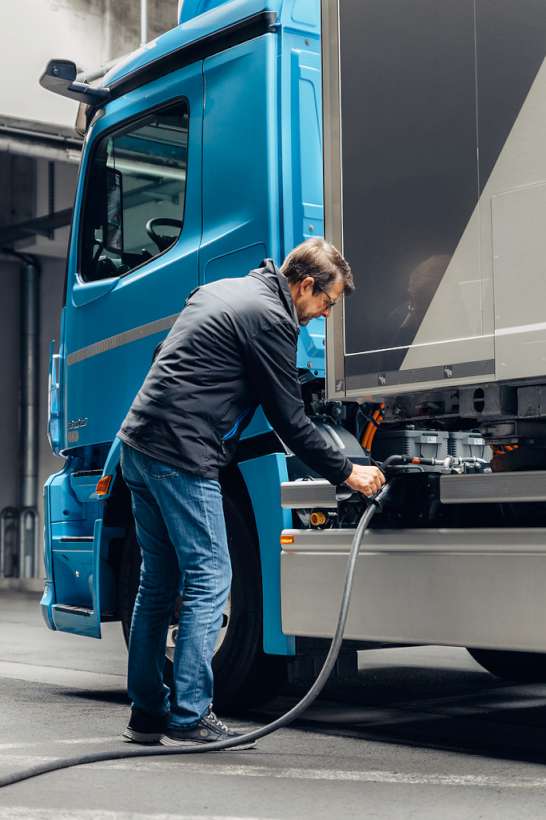As of today, the answer to the question is – practically nowhere in the UK. However, since you can’t buy a ‘proper’ 44 tone 6×2 artic any time soon – even for the half a million pound price tag that would come with it – perhaps that’s not a huge issue today because it is not way until 2040 that you won’t legally be able to buy a diesel truck over 26 tonnes GVW anymore.
This deadline is shorter for trucks up to 26 tonnes, however. This is only a dozen years away in 2035. If you run vans then this deadline is 2030, but these should be able to use facilities that are being put in place for cars.
The people in the know tell us that inside two years there will be a number of trucks available on the market that will be able to run for four and a half hours, recharge during the driver’s rest stop, then drive for another four and a half hours. Once this happens, it is just a question of the price of these machines.
There is plenty of work going on by lots of interested parties in this area, but the operators appear to be less interested at this stage. At a recent presentation a the ITT hub, there was a large room full of people listening to presentations from the DfT, National Grid, consultants and large 3rd party logistic operators, but less than a handful of these were actually truck operators.
The Grid
It’s not that nothing is happening. There are plenty of groups and quangos looking into all areas of the electrification of our refuelling infrastructure. There’s even some budget allocated to projects already.
It’s nowhere near as simple as dropping in a charging point, however. These facilities require a significant ‘beefing up’ of the cabling and infrastructure that feeds the power to the sites. Many operators will fall foul of this when ordering their new electric trucks for the first time and expecting the installation of the own depot charging points to be straightforward!
There has been a recent rule change that will make all of this this easier – or at least cheaper. Prior to April 2023, if an operator wanted to install a 2MW charging facility onside for 30 trucks, for example, not only would there be the charge to upgrade the connection to their site, but there may well have been a charge to upgrade the connection to the whole town. Both of these costs would have been borne by the truck operator. It is only in recent weeks that this has changed so that the operator only needs to cover their own costs.
Other areas where ‘the grid’ could get ahead of the game is to use the funding available for the installation of the cabling to the UK’s strategic road network motorway service areas for installing car chargers. It makes sense to put the cabling in that will also cater for the trucks at the same time. There is £950m available for this initiative and it could put trucks on the path to a ‘proper’ national electric refuelling network.
Away from Base Charging
Despite the issues of home base charging, it is much more likely that these will be in place before there is any kind of viable national recharging network available. It will be down to the early adopters running trucks under 26 tonnes who will be installing facilities in their home depots that will make it easier for those companies coming along later with the requirements for huge numbers of 44 tonne artics to be charged simultaneously.
Scania’s Public Charging Initiative
Still a little hush hush at this stage – especially regarding their network partner, but Scania has announced that they will offer a Europe-based charging network suitable for mixed fleets of trucks and buses. Launching this October, it is likely that this will concentrate on the continent, rather than our small island.
“Scania Charging Access will help iron out the hurdles and stress connected to en-route charging by offering an extensive network and hassle-free administration,” says Fredrik Allard, Senior Vice President and Head of E-mobility at Scania. “This service will no doubt be welcomed by hesitant haulers and transport buyers. It will help lead the way towards the large-scale electrification of buses and trucks in different applications in Europe.”
Scania cannot disclose its network partners yet, but Allard says there is potential for local Scania dealer networks and major providers within the car charging business to join Scania’s charging service.
He continues, “I am not saying we are philanthropists, but the main target is to create the necessary infrastructure for sustainable transport. I really hope that other OEMs will support this by also introducing shared networks for mixed fleets, offering customers access to the broadest possible charging network for trucks in Europe.” Learn more: scania.com/charging

PS – Want a Free Electric Demonstrator Truck?
Well, you’re too late. The competition closed last October for a slice of the £140 million to Innovate UK, part of UK Research and Innovation, will work with the Department for Transport to invest up to £140 million in a multi-year demonstration of 40-44t battery electric trucks which should “Include the development of the required business models for scalable deployment and a network of dedicated infrastructure.”
There are some announcements due soon covering who has been awarded the money and what this will mean to the number of electric trucks on the UK’s roads.
Good Luck!
